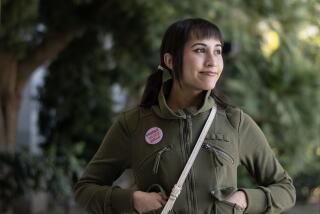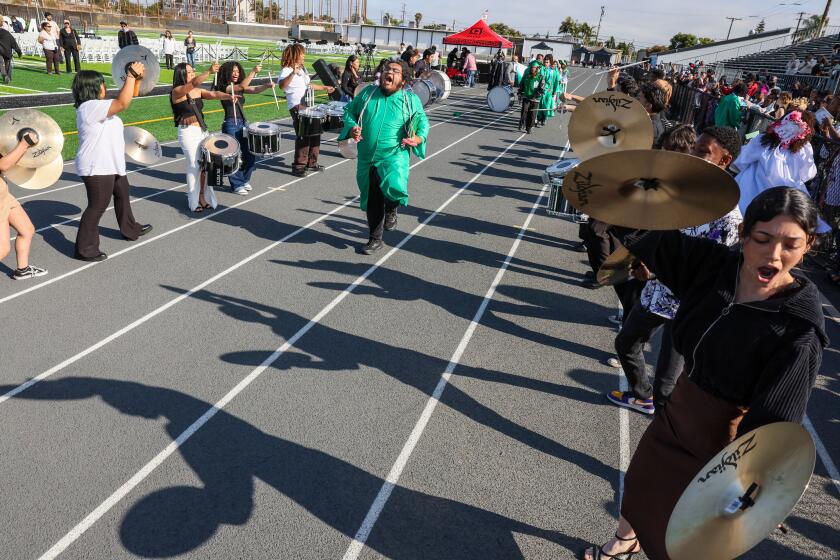After Racial Violence, an Uneasy Peace Takes Hold : Education: Black and Latino students at Chatsworth High are making a concerted effort to mend fences in the wake of a Sept. 30 brawl.
Polite silence--or at best a token smile--was usually all that transpired when Liegia Benson passed by most Latino students in the halls of Chatsworth High School or saw them in some of her classes.
But that was before a racial brawl involving dozens of black and Latino students ripped through the normally placid campus on Sept. 30. Now, more than a month after the melee, the situation has changed between Liegia, who is black, and some of her Latino counterparts.
“In my classes now, there are some Hispanics who say, ‘Hi,’ and I say, ‘What’s up,’ ” said Liegia, a 16-year-old junior. “We don’t hold a conversation, but we say ‘hi’ and ‘bye.’ It’s like we’ve gotten closer.”
This new attitude is the result of students and administrators making a concerted effort to mend fences in the aftermath of the brawl. With teen-age leaders who keep tabs on their peers, discussion groups that focus on race relations and even a new class that will center on conflict resolution, the atmosphere at Chatsworth appears to have taken an upward turn.
“Everything is cool now,” Liegia said.
Not that racial division or distrust has suddenly evaporated, or that the road to improved relations hasn’t been rocky.
A day or so after the violence erupted, Latino and black student leaders meeting to try to reach a compromise were brought up short when a metal butter knife found its way out of someone’s pocket and clattered onto the floor.
But no one jumped to their feet or to sudden conclusions, as happened during the confrontations that had flared throughout the previous morning. An awkward minute or two ensued, punctuated by an uneasy explanation from one student and an acerbic comment from another.
And eventually the two groups--since dubbed “The Chatsworth 16”--aired their grievances, uncovered misunderstandings and filtered the word to their respective cliques that acrimony and fighting were no longer necessary or justified.
“We had to make an agreement to bow down, to say something to each other,” said senior Harold Cleveland, 17, who acted as a mediator.
“It was a two-way thing,” agreed Luis Ortiz, also 17. “They apologized, and we apologized. . . .
“It should have never happened,” he went on, recounting how the brawl began when a black youth tried to intervene in a dispute between two Latino students. “One little incident--it wasn’t even race-related, and it turned into a race thing.”
Some of the “16” participated in the brawl, which resulted in arrests, suspensions and expulsions.
Over the past month, the committee has gained new members, and the dialogue between the two sides has expanded to include discussion of issues that, to the students’ surprise, turned out to be of common interest. Many of the teen-agers identified what they considered a lack of sensitivity toward minority students from some staff members, who seemed quicker to harass or punish them than Anglo students.
“We weren’t really different,” said Luis, who rides the bus from Pacoima to school each day with his identical twin. “Everything we said was the same--how the staff treats us, the preference to white students.”
“Now we see they have some of the problems we have, so we try to work together,” Liegia added.
One of her complaints is that this year’s winners of the “senior superlatives”--the graduating seniors voted as most talented or best in other categories--are all Anglo, although some minority students did appear on the ballot. Overall, the Chatsworth student body is about 44% Anglo and 56% minority.
Assistant Principal Denny Thompson, who has spearheaded the effort to bring calm to the campus, acknowledged that minority students, particularly blacks and Latinos, believe that they are regarded unfavorably by certain teachers and administrators.
“You often see these problems when ethnicities change” on campus, he said, referring to the transformation of Chatsworth over the past decade from a predominantly Anglo school to one that is more ethnically diverse. “Schools have to grow like societies have to grow.”
While he is working to resolve complaints from minority students of unequal treatment from staff, the senior superlatives election is, unfortunately, a “done deal,” he said.
But Liegia isn’t satisfied.
“If it was all black students, it wouldn’t be a done deal. If it was all Hispanic students, it wouldn’t be a done deal,” the North Hollywood teen-ager said.
Her grievance is exactly the kind of problem history teacher and football coach Bill Payden hopes his new “communicators” class, to be added next semester, will address and help solve.
Developed by Payden and other teachers in the wake of the brawl, the communicators curriculum will concentrate on conflict resolution, cultivating leadership skills, building self-esteem, teaching cultural awareness and learning how to deal with human relations issues.
The class will probably include some of the Chatsworth 16 and also Anglo and Asian youths so as to be “a true representative body” that can act as a liaison between administration and students, said Payden, whom Thompson called a “Pied Piper” because of the respect and deference paid him by students.
“There’s a certain amount of political activism in me as a child of the ‘60s, and as a teacher I’d like to seem them channel their energies in a positive direction,” said Payden, who is black.
But despite the efforts to create a more peaceful climate on campus, another goal seems more elusive: getting the different ethnic cliques to mingle and socialize. During the half-hour midmorning break each day, for example, students still tend to clump together according to ethnicity.
To some extent, “that’s natural,” said Joel Juntilla, a youth relations assistant with the Los Angeles Unified School District who was called out to Chatsworth after the melee to expedite a resolution. “There still needs to be a lot more growth in that area--getting them to come together.”
Juntilla noted that misunderstandings and some anger still remain between students of different ethnicities, which he hopes to dispel in discussion groups he helps facilitate once a week on campus.
Last week, some of that bitterness surfaced during a spirited debate by one of the groups over a newspaper article that described the efforts of some Anglo students to form a white student union at Ventura High School after a group of black students had formed their own club.
“That’s the same as the KKK,” declared a visibly angry Robert Carpenter, 17, a black senior from South Central Los Angeles. “ They say they’re not prejudiced, that they just want to know about where they come from,” but their aim is less innocent, he said.
His comment stirred a response from junior Justine McCabe, who is white.
“If we were to have a white awareness club, people would say now we’re having a KKK and crap like that. But it’s the same as the Black Awareness Club, the Latino Club, the Asian Club,” she said, referring to student organizations at Chatsworth. “But people have grudges against white people.”
“Do you blame us?” Robert countered.
After the discussion, Juntilla said that the students may not have been ready for such controversial topics, but that the group would address similar subjects again after establishing a greater level of trust among themselves.
And even Payden, who is busy developing his communicators class, doesn’t see in his new project an instant answer or panacea for the tension that can still ripple through the campus.
“The whole thing may be too idealistic,” he said. “It may be a fantasy. But if nothing else, it removes the argument that they’re not being treated fairly.”
More to Read
Sign up for Essential California
The most important California stories and recommendations in your inbox every morning.
You may occasionally receive promotional content from the Los Angeles Times.







